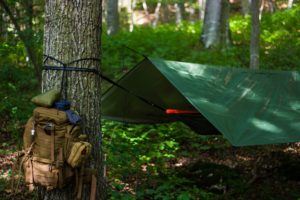When you go camping, you want to have fun. However, you want to make sure you’re safe as well. Although camping traditionally involves pitching a tent, hammock camping has become very popular as well.
Is it safe to camp in a hammock? It is safe to camp in a hammock, as long as you observe the following rules:
- Respect the area rules.
- Make sure the selected location is not on a trail and is safe.
- Hang the hammock low to the ground.
- Be careful with your movements in the hammock.
- Bring a weather shelter.
Read on to find out how you can have a memorable and fun camping experience with your hammock!
What is Hammock Camping?

Hammock camping means you are going camping using a hammock rather than a tent. Instead of sleeping on the ground under cover of a tent, you will be sleeping in a hammock that you perch in a safe location.
What You Need for Hammock Camping
To go hammock camping safely and successfully, you will need a few items. This includes the hammock itself, in addition to the following:
- A suspension system, to strap your hammock to the trees
- A sleeping pad or underquilt, especially if it is cold outside
- A weather shelter
- Bug netting
These last three items are somewhat optional, although they can help make your hammock camping experience quite a bit more pleasant.
As far as the suspension system goes, you want to make sure that you get a good one with wide straps that will support the hammock and your weight. The straps will also make your suspension system easy to set up. Many of these suspension systems have protective sleeves around the ropes so that they don’t end up damaging the bark of the trees that you use. (Source: REI)
Is It Safe to Camp in a Hammock?
It is indeed safe to camp in a hammock if you follow proper safety procedures. These include the following:
- Check the rules. Make sure that you are familiar with any park rules regarding hammock camping.
- Check the surroundings. If you’re able to set up a hammock, make sure to do so away from trails and paths. Otherwise, setting up a hammock could present a safety hazard to people in the area.
- Pick a safe location. It’s crucial that if you are going to hang a hammock, it’s in a safe spot. If you’re going to use trees, make sure to use trees that are alive and sturdy. If a tree is dead, severely leaning, or containing rotten wood, this may not be the best place to hang your hammock. You must make sure that whatever you use to anchor your hammock is capable of supporting your weight, whether you are using trees, shelters, or even your vehicle.
- Hang it low. You should try to hang your hammock so that it’s approximately 18 inches off of the ground when you’re sitting in it. This way, if it happens to fall, you won’t fall too far.
- Be careful in your positioning. When you’re entering the hammock, first sit, and then swing in your legs. You’ll probably be most comfortable if you lay diagonally at a 30 to 45-degree angle. Try not to make any big, sudden movements while you are in the hammock.
- Bring a weather shelter for your hammock. The weather can be unpredictable, and you not only have to think about rain, but also tree branches coming down that could injure or even kill a person.
(Source: Kammok)
Why People Hammock Camp

You might wonder why some people are getting into hammock camping, rather than continuing to go with the tried-and-true tradition of camping in a tent. It turns out that there are a few reasons that people enjoy camping in their hammocks.
Comfort
If you are sleeping in hammocks, you don’t have to deal with some of the potential discomforts of sleeping on the ground. These can include rocks that dig into your back, bugs on your skin, roots, and a slight slope in the ground that you may not have noticed when you first pitched the tent.
Another aspect of comfort to consider is the clothes you wear while camping. Check out this post to learn more about the best attire for being out in the wilderness.
However, there are a few challenges that come with sleeping in a hammock. After all, you do need to learn how to lie in it properly to be comfortable. Once people have figured out the most comfortable positions, they have often reported that it is more comfortable than sleeping on the ground.
More Location Options
You have more options in terms of location with a hammock than you do with a tent. You can:
- Tie up your hammock over a stream
- Under a pier
- Between trees
- Between a couple of car racks
You also get more exposure to nature and fresh air when you are sleeping in a hammock.
Simple Setup and Transportation
While not every hammock is necessarily easier to set up in a tent, this is the case on average. When you set up a tent, most of the time, you have to deal with poles and stakes and may not even know if you are doing it correctly. In contrast, the majority of hammocks can be set up within minutes.
Also, a hammock will usually make for a lighter and smaller load than a tent will. Even though you can bring a pillow and sleeping pad, you will be less likely to need one than you will in a tent. Many hammocks only weigh a few pounds, even with added accessories such as a weather shelter.
A tent that can be heavy and cumbersome to carry around. A hammock can be very sturdy and safe, even though you are dealing with less material.
(Source: Art of Manliness)
Wild Animals and Hammock Camping

When you go camping, you need to remember that you might encounter some local wildlife in the area. Every area is going to be home to different types of animals.
There are a few things that you can do to keep yourself safe from wild animals while hammock camping:
- Keep your food far away while you’re sleeping. Having your food with you will make you more likely to be the target of an attack. It should be at least a hundred feet away from your campsite and hammock. If there are no bears in the area, you can hang your bag of food from the branch of a tree far away, at least 10 feet off the ground and four feet away from the tree. If there are bears in the area, they will usually be able to get your food even if you do this, so bringing a bear canister would be a good idea in these situations.
- Set your hammock a little bit higher if there are lots of animals. If there are lots of small animals, such as raccoons and snakes, in the area, it would be a good idea to suspend your hammock a little bit higher than usual.
- Don’t set up camp right next to a water source. Animals are more likely to congregate in these areas, and it’s generally better to sleep far away from them.
(Source: SERAC)
Final Thoughts
Camping can be a great experience. You get to see nature up close and experience everything that it has to offer. Whether you decide to camp in a tent or a hammock, it’s undoubtedly going to be a unique experience for most people. If you’re willing to take the risks associated with hammock camping, this experience adds a whole new dimension to camping.
For many people, using a hammock instead of a tent can make camping much more pleasant and enjoyable. However, you must respect all safety rules to maintain a positive experience. The last thing you want is to end up injured or worse because you thought that you would be able to get away with ignoring hammock safety rules.






